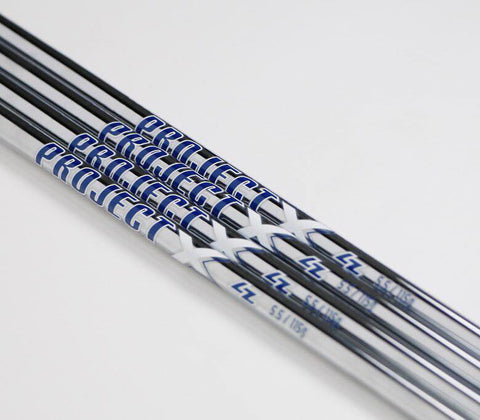Project X Steel Shafts for Irons
Project X is now also involved in the market for wood and driver shafts. However, this shaft became famous for its unique "rifle design" without the usual steps. Project X played a major role on the Tour from the very beginning with its basic low launch, low spin profile. Players like Rory McIlroy do not think about changing the shaft.
Meanwhile Project X is part of "True Temper", but has not lost any of its original concept. Over the years, more shafts have been added to the original Project X, most notably the Project X LZ, which is also very popular on Tour. But also off the Tour, Project X wants to continue with new shaft concepts such as the Project X IO or the Catalyst, a graphite shaft with the characteristics of steel shafts.

Project X Rifle
This shaft is constructed without steps and therefore has a unique design. However, this is not only an advantage in terms of design but also in terms of flex distribution and energy transfer. And this without having a negative influence on control. This stepless construction makes the tip very stiff and therefore provides more precision with optimal control of trajectory and spin.
The bend profile of the Project X is quite interesting and roughly comparable to the Nippon Modus 3 120. The end of the grip is relatively soft and becomes stiffer as the grip progresses, in the middle very soft and in the tipp stiffer again. Exactly this stiff tip is decisive for the profile with low spin and low trajectory.

Project X LS
The Project X LS stands for low spin and further enhances the "low spin characteristic". The LS was just released in 2020 and has a brushed finish. Like the Project X Rifle it has no steps. The LS is even softer in the grip area than the Project X rifle. This makes it possible to make the other parts of the shaft even stiffer. Therefore the Project X LS is really only designed for very athletic players who swing very aggressively. The difference to the Project X rifle though is marginal and probably only noticeable for extremely good players.
Project X IO
This shaft concept is already known from the Dynamic Gold AMT shaft, where the shafts for longer irons are becoming lighter and lighter. Basically, we believe this concept is only useful for players who really struggle to launch the ball with long irons.
Project X LZ
The Loading Zone Technology makes this shaft unique and gives it its name: LZ. It enables a 7% greater transfer of energy to the ball and therefore ensures greater distances. This technology is not only visible in the club, but can also be seen in the conical steps from the grip through the middle section of the Project X LZ.
As far as the profile is concerned, the Project X LZ differs significantly from the Project X Rifle and is, for example, an alternative to the Nippon Modus 120. However, the profile of the LZ is much more pronounced than the Modus, namely very stiff in the lower part of the grip, very soft in the middle and again a stiff tip - the latter is the prerequisite for an overall low launch with little spin.
The stiffness of the shaft should not be underestimated and the LZ is even stiffer than the Project X rifle. That's why the Project X LZ in 7.0 is only available as a tour version and is played by Tommy Fleetwood, for example. For us normal mortals this variant is not available, but Project X 7.0 is.

Project X vs. Project X LZ - Our Review
When comparing the data, it quickly becomes apparent that the Project X LZ is a little stiffer than the Project X of the same rank. This means that a Project X 6.0 is about as stiff as the Project X LZ 5.5 - but also a little lighter. So if you generally tend towards lighter but stiffer, you should have found a candidate in the Project X LZ.
However, the differences are not dramatic. For our test, we nevertheless compared Project X 6.0 with Project X LZ 5.5 because these shafts have practically the same stiffness.
The results are as follows:

In terms of launch and spin, we would not find any differences based on this test. The Project X LZ shows a little more spin, but this is mainly due to the strike pattern. It makes no sense to classify one of the shafts with a higher launch or more spin.
The big difference is in the profile and this is particularly evident in the transition. Our player got along much better with the Project X with its relatively aggressive transition from backswing to downswing. This is also reflected in the result and especially in the outliers that did not make it into our analysis.
Our test player noticed relatively early on that the aggressive transition gets him into trouble more easily - which can also be seen directly in the dispersion. A large part of the balls were either slightly blocked or slightly closed. A typically poor strike pattern for good players who get to the ball from the inside.
The comparison of Project X and Project X LZ is an example of how individual shafts can be. Another player might have achieved exactly the opposite result.

